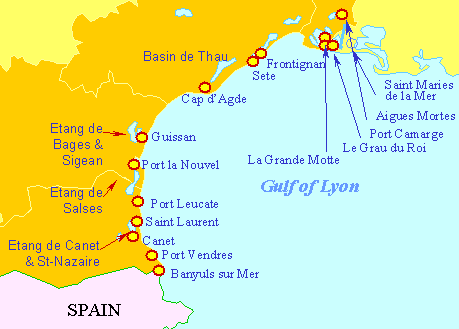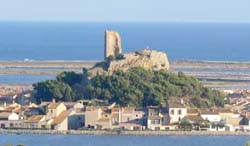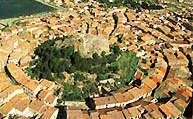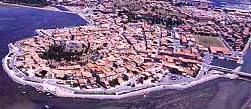
 Gruissan
lies on the Mediterranean
coast of the Languedoc not far from Narbonne,
between the hills of the Clape, étangs (salt lakes)
and the Mediterranean
Sea. It is in the Aude
département
Gruissan
lies on the Mediterranean
coast of the Languedoc not far from Narbonne,
between the hills of the Clape, étangs (salt lakes)
and the Mediterranean
Sea. It is in the Aude
département
It was originally a fishing village on an island surrounded by water and marshland. Today Gruissan is surrounded by miles of beaches of fine white sand.
The warm waters of the Mediterranean Sea offer safe bathing for children here. French holiday makers favour the 1300 stilted wooden beach chalets (made famous by the film "Betty Blue").

![]() A
yachting
marina with holiday apartment buildings around the palm-lined
quays, has turned a once quiet working village it into a
popular holiday destination. People have different opinions
as to whether 1960s archiecture has improved it.
A
yachting
marina with holiday apartment buildings around the palm-lined
quays, has turned a once quiet working village it into a
popular holiday destination. People have different opinions
as to whether 1960s archiecture has improved it.

![]() Gruissan
offers sporting and aquatic activities including windsurfing,
sailing, riding, cycling and an amusement park. Night life
includes bars and restaurants around the Marina,
where you can eat while overlooking the yachts and listen
to musicians playing various types of music. There is also
a Casino and four nightclubs.
Gruissan
offers sporting and aquatic activities including windsurfing,
sailing, riding, cycling and an amusement park. Night life
includes bars and restaurants around the Marina,
where you can eat while overlooking the yachts and listen
to musicians playing various types of music. There is also
a Casino and four nightclubs.

![]() The
heart of the village of Gruissan is a small fishing harbour,
next to the castle. It is always lively, but especially
in June. On 29th June the local fishermen celebrate the
feast of Saint Peter, the patron saint of fishermen (and
of Gruissan). Watch the processions and the blessing of
the boats - a Christianised remnant of Languedoc's pagan
past.
The
heart of the village of Gruissan is a small fishing harbour,
next to the castle. It is always lively, but especially
in June. On 29th June the local fishermen celebrate the
feast of Saint Peter, the patron saint of fishermen (and
of Gruissan). Watch the processions and the blessing of
the boats - a Christianised remnant of Languedoc's pagan
past.
Three mornings each week, the village holds an open-air market. Brightly decorated stands offer local produce: fruit, vegetables, wine, fish and other sea food. You can even buy fresh fish direct from the fishermen.

![]()

![]() As
in many Languedoc towns and villages, the narrow streets
of Gruissan have grown organically around a donjon or castle
tower. This one, largely in ruins, dates from the13th century.
A tower was originally constructed here at the end of the
Tenth century to keep an eye on ships sailing towards the
harbour of Narbonne and so help protect the city against
pirate sea raids and berber incursions. A hundred and fifty
years later, Guillaume of Broa, Archbishop of Narbonne,
strengthened it and flanked it with a tower now known as
the Barberousse Tower ("Red Beard" Tower). The
tower was dismantled in the Sixteenth century on the orders
of Cardinal Richelieu and has been neglected ever since.
As
in many Languedoc towns and villages, the narrow streets
of Gruissan have grown organically around a donjon or castle
tower. This one, largely in ruins, dates from the13th century.
A tower was originally constructed here at the end of the
Tenth century to keep an eye on ships sailing towards the
harbour of Narbonne and so help protect the city against
pirate sea raids and berber incursions. A hundred and fifty
years later, Guillaume of Broa, Archbishop of Narbonne,
strengthened it and flanked it with a tower now known as
the Barberousse Tower ("Red Beard" Tower). The
tower was dismantled in the Sixteenth century on the orders
of Cardinal Richelieu and has been neglected ever since.

![]() You
can also visit the chapel Notre Dame des Auzils, on top
of the Massif de la Clape. A steep path winds through a
tree-shaded "sailors' cemetery" - a cemetery without
bodies (the 26 memorials lining the path are all to people
lost at sea). Walk up a path amongst pine trees climbing
the hillside, past a herb garden and a hermit's cave, to
the chapel. Here there is a spectacular view of the coast.
On entering the chapel you will see a collection of paintings,
model ships, and marine memorials. The 13th century chapel
(open from 3--6 p.m. during the summer) contains sailors'
votive offerings, placed here to buy safety on their journeys.
Some 60 of them were stolen in 1968, so the local priest
had them replaced by trompe l'oeil paintings. On Easter
Monday, there is a procession to the chapel, where a service
is held for those at sea.
You
can also visit the chapel Notre Dame des Auzils, on top
of the Massif de la Clape. A steep path winds through a
tree-shaded "sailors' cemetery" - a cemetery without
bodies (the 26 memorials lining the path are all to people
lost at sea). Walk up a path amongst pine trees climbing
the hillside, past a herb garden and a hermit's cave, to
the chapel. Here there is a spectacular view of the coast.
On entering the chapel you will see a collection of paintings,
model ships, and marine memorials. The 13th century chapel
(open from 3--6 p.m. during the summer) contains sailors'
votive offerings, placed here to buy safety on their journeys.
Some 60 of them were stolen in 1968, so the local priest
had them replaced by trompe l'oeil paintings. On Easter
Monday, there is a procession to the chapel, where a service
is held for those at sea.
Local Industries
Traditional "artisan" fishing is still practiced here. 23 small establishments catch sea bream, sea bass, mullet, mackerel sardines cuttlefish and flat fish such as sole, turbot and brill. Since 1988, shellfish farming in the open sea has been practiced, producing oysters and mussels.
In spring and summer, five crews fish by dragging. Early in the morning, a fishing net is pulled onto the beach. Everyone, including holiday makers is invited to participate in hauling it up.
In winter, the fishing switches to the salt lakes "pantanes". Here the catch includes eels (which are exported to Germany, Italy, Belgium,and the Netherlands.

![]() Apart
from fishing, the other traditional industry around Gruissan
is salt making - it is the residue of evaporated sea water.
You can see the "fields" of salt water and piles
of brown and white salt - called camelles because
of their resemblance to the humps of camels. Salt pans cover
a total surface area of almost 400 hectares between the
sea and the island of St Martin. The harvest has grown from
around 5 tons in 1912, to more than 30,000 tons today, in
a good year. The salt, "Fleur de sel" from the
Audois region competes with a similar product of the same
name made a little further north along the coast in the
Camargue. The salt-works are protected against heavy
seas by a mile long sea wall. Driving along the coast road,
you can see large white camelles. Water is pumped
into the salt pans in spring. It evaporates during the summer,
and salt is harvested in autumn. During the summer, you
can take a guided tour around the salt pans.
Apart
from fishing, the other traditional industry around Gruissan
is salt making - it is the residue of evaporated sea water.
You can see the "fields" of salt water and piles
of brown and white salt - called camelles because
of their resemblance to the humps of camels. Salt pans cover
a total surface area of almost 400 hectares between the
sea and the island of St Martin. The harvest has grown from
around 5 tons in 1912, to more than 30,000 tons today, in
a good year. The salt, "Fleur de sel" from the
Audois region competes with a similar product of the same
name made a little further north along the coast in the
Camargue. The salt-works are protected against heavy
seas by a mile long sea wall. Driving along the coast road,
you can see large white camelles. Water is pumped
into the salt pans in spring. It evaporates during the summer,
and salt is harvested in autumn. During the summer, you
can take a guided tour around the salt pans.

![]() Amore
recent industry is tourism.
Amore
recent industry is tourism.
Tourist Office
1 boulevard du Pech Meynaud
11430 Gruissan
Tel: 33 (0)4 68 49 09 00 or (0)4 68 49 03 25
Website:
http://www.tourisme.fr/office-de-tourisme/gruissan.htm
(In French only)
Local Wines
Nearby are vineyards, including some particularly good ones, for example around the foothills of the Clape Mountain. This terroir enjoys a mild and suitably windy microclimate, suitable for the red, rosé and white wines. These wines, made from a wide range of grape varieties, were awarded the classification of AOC (appellation d'origin controllé) in 1985.
For white wines the dominant grape variety is Bourboulenc, when combined with the white Grenache, Clairette and Maccabeu, it produces pale straw coloured wines with a subtle aroma of flowers.
Reds are balanced and are made mainly from Syrah, Mourvèdre, and Grenache grapes and to a lesser extent Carignan and Cinsault grapes, they offer a rich bouquet with aromas of spices and the local garrigue. They often age well.
Rosé wine is made from the same grape varieties as the red wines. Most of these wines are produced by draining the juice from the grapes, without pressing them (so rosé wines are not coloured by the grape skins as the red wines are).
Other Attractions
Beaches. Apart from standard beaches, there is a naturist beach between Gruissan and Les Ayguades. To get there, take the D32 from Narbonne to Gruissan. Follow the road into Gruissan, taking a left past the Casino, then follow the road straight on over several roundabouts, passing a fun fair to your left and a number of lotissments to your right. Continue until you will see a sign for Les Plages. The road continues past a windsurfing and yachting building on the sand to your left and the yachting marina entrance on your right. Follow the road to a car park area, where a sandy road leads down to the beach. Drive across the beach towards the first Lifeguards' House, and continue to you see other naturists."Fumeries Occitanes" where a wide range of salt and fresh water fish are salted and smoked (including tuna, swordfish and shark).
Museum of wine and winegrowing in Château le Bouis;
Salt museum at Les Salins du Midi (open March 1 - Oct 31).
Other places to visit in this area:






